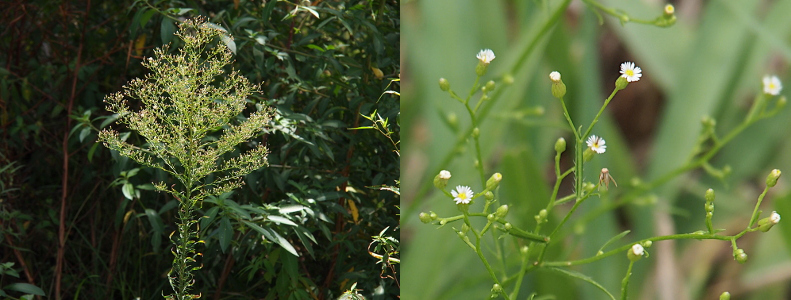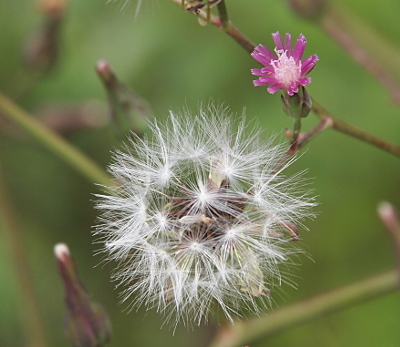Here are the rest of the grasses, herbs, and interesting plants I saw in Jacksonville, Florida.
page 16 of 19 of Jacksonville scenes
- - - - - - - - - - - - -
These buds were atop a very long thin stem growing near the water. (May 29, 2022)
![[Against the blue background of the water is a thin green stem which branches into three stems with a grouping of greenish clumps at the top from which teeny tiny purple flowers peep out.]](Photo/Jacksonville-FL/20220529 - flowers.jpg)
This is the same type of plant as in the previous photo. On the left is the entire plant and on the right is a close-up of the tiny blooms (April 21, 2023)
![[On the left are several stalks approximately three feet tall. At the end of branches near the top are purple groupings. These plants are growing several feet from the water. On the right is a very close view of the purple groupings. There are dark purple balls from which tiny light purple five-petals flowers protrude. Each purple ball has at 5-6 little flowers.]](Photo/Jacksonville-FL/20230421 - purple buds on tall stems.jpg)
Two different types of foxtail plants (June 26, 2017 on left and Sept. 5, 2019 on right)
![[On the left a single stem protruding from the left is a long cylindrical seed head. The seeds at the center are small and green and surrounded by long thin spikes which protrude from the stem giving the impression of a cylindrical brush. On the right is long cylindrical vertical head at the top of a green stem. The bristles are all light brown and are tapered to a point at the top.]](Photo/Jacksonville-FL/20170626 and 20190905 - foxtails.jpg)
Foxtail amid the grass in the morning sun (July 12, 2020)
![[At least several dozen foxtail plants with their tips slightly angled (to the ground protrude above the green blades of grass. The sunlight catches the outer edges of the foxtail spikes making them appear as if they glow.]](Photo/Jacksonville-FL/20200712 - foxtails.jpg)
Two different sandbur plants (Sept. 5, 2019)
![[Two images spliced together with the one on the right being a closer view of the burs which are spheres with long spikes protruding from them. The image on the left is a single spike of approximately a dozens burs atop the green leafy stem. The image on the right is a close view of several spikes of burs.]](Photo/Jacksonville-FL/20190905 - sandburs.jpg)
Crowfootgrass (September 26, 2017)
![[On a single stem protruding from the left is a five-stemmed top resembling a star or pinwheel. Each stem is similar to the foxtail in the prior image in that there are seeds and spikes on them although these spikes are much shorter and the seeds thicker.]](Photo/Jacksonville-FL/20170926 - star-top weed.jpg)
Nutsedge (June 4, 2017)
![[This is an all-green plant with a single stem which branches into many stems at the top. At the top of each of the short stems are star-shaped globules of short spikes.]](Photo/Jacksonville-FL/20170604 - nutsedge.jpg)
This is possibly yellow nutsedge. (July 16, 2019)
![[This plant has 'blooms' which are a multitude of spikes (15-20) which have hair-like twisties around all the spikes. While the stems are green, the spikes are golden with the white hairs.]](Photo/Jacksonville-FL/20190716 - yellow nutsedge.jpg)
Canadian horseweed (August 2, 2018) and a close view of the blooms (September 5, 2019)

Bushy bluestem (November 5, 2018)
![[The stalks of this plant are 3-4 feet tall and blue-green in color. This image is the tops of the plant which has fluffy cottony tops on the blue stems. The fluffy part is white-beige and looks like one could pull these plants out of the ground and bundle them together to use as a broom of sorts.]](Photo/Jacksonville-FL/20181105 - bushy bluestem.jpg)
Anole at the top of a bushy bluestem (November 5, 2020)
![[A brown anole with a white chin is resting in the bushy tops of a bushy bluestem.]](Photo/Jacksonville-FL/20201104 - anole in bushy bluestem.jpg)
This very tall plant has a stem which extends well above its leaves. The top appears to be future blooms. (June 18, 2022)
![[Two photos spliced together. On the left is the entire plant growing amid other greenery. The very long stem protruding above the leaves mostly blends in with the background greenery, but the tip is definitely visible because it is so far from anything else. On the right is a very close view of the top of the plant. It has green stems twined together with purplish closed buds at the top. ]](Photo/Jacksonville-FL/20220618 - plant.jpg)
Cattails with a few white duck potato arrowhead flowers (June 28, 2020)
![[The stalks of this plant are 3-4 feet tall with an approximately six inch thick brown section near the top. The leaves and stems are green and this water section is loaded with these plants. The leaves are long and thin and top out at higher than the stem with the brown section. There are a few white flowers with their wider leaves growing amid the cattails.]](Photo/Jacksonville-FL/20200628 - cattails closeup.jpg)
Rattlebox (April 17, 2021)
![[The stems of this plant are 4-6 feet tall with branches containing many leaves. Red flowers grow in groupings at different sections of the stems along their own branches. It's sort of a mini tree, but dies completely to the ground to grow again each year.]](Photo/Jacksonville-FL/20210417 - rattlebox.jpg)
Two different stages of the seed pods of the Rattlebox plant (October 21, 2023)
![[Two photos spliced together. On the left are a multitude of flat yellow-green pods hanging from a branch. It appears there will be seeds on each half of the pod. On the right are brown dried-looking pods which have bulges from the seeds.]](Photo/Jacksonville-FL/20231021 - rattlebox fresh and aged.jpg)
Seed pods of a different variant of Rattlebox plant (November 21, 2023)
![[This plant has only seed pods on the outer ends of the branches and many appear to have already fallen to the ground, but may fat green pods still hang from the plant and are easily seens because they hang over the water which is a different color.]](Photo/Jacksonville-FL/20231121 - rattlebox fruits 6.jpg)
Closer views of these seed pods which eventually turn puple (November 21, 2023)
![[Two images spliced together. On the left are fat elogated all green pods hanging from a branche. Each pod has a dark vertical stripe the length of the pod. On the right are all purple pods extending from a branch. ]](Photo/Jacksonville-FL/20231121 - rattlebox fruits 3 and 11.jpg)
Common sheep sorrel (March 23, 2016)
![[This is a multi-branched plant with very tiny flower petals all along the ends of the green branches--so many petals that the green can only be seen in a few places. These petals are red at the ends of the branches and white or pink in other places.]](Photo/Jacksonville-FL/20160323 - red-white tiny flowers.jpg)
Interesting-looking seed heads (September 25, 2016)
![[More than a half-dozen fully-opened seed heads at the end of green stems are a mixture of light-brown centers with white edges. Some small light-brown seeds are visible, but the heads are mostly spiky spheres.]](Photo/Jacksonville-FL/20160925 - flowers 2.jpg)
The seedhead is much larger than the bloom on this grassleaf lettuce. (April 22, 2018)

A very full seedhead (April 17, 2021)
![[The seedhead has so many thin white spikes emanating from the center that it gives the appearance of a cotton ball.]](Photo/Jacksonville-FL/20210417 - seedhead.jpg)
A very heavy dew on a seedhead (February 11, 2021)
![[The spikes on this seedhead are completely covered in teeny tiny dewdrops. It looks like a bumpy frosted white globe as spherical drops cover the length of each spike. Because the dewdrops are so small, they appear white rather than clear.]](Photo/Jacksonville-FL/20210211 - dewy seedhead.jpg)
Air potato plant is a non-native invasive species with large leaves and white puffy globes which resemble potatoes. (September 16, 2019)
![[A vine drops from the top of the image and curls at the bottom of the image near some cement. Three white spheres attach to the vine equi-distant from each other. The large leaves, some more than six inches wide, also attach to the vine and are globular in shape.]](Photo/Jacksonville-FL/20190916 - air potato 2.jpg)
The right side image is a close view of the swamp titi on the left. (May 18, 2020)
![[Two photos spliced together. The image on the left shows the many 'arms' of the plant which grows low to the ground. The right image is a close view of the green branches with a multitude of tiny blooms along the entire length of multiple sides of the branches. The blooms appear to be small white cylinders which then open showing the thin white stamen. ]](Photo/Jacksonville-FL/20200518 - flowering weed.jpg)
Interesting leaf shape on this plant. (October 23, 2021)
![[This plant has three leaves and the shape of each leaf resembles butterfly wings that are open flat.]](Photo/Jacksonville-FL/20211023 - interesting leaves.jpg)
Duckweed is a plant which grows atop the water and provides food for many creatures. (September 5, 2019)
![[In the right side of the image completely covering the water are a series of small green circles interspersed with some brown flotsum. There is a clear demarcation between where the duckweed is growing and the clear water.]](Photo/Jacksonville-FL/20190905 - duckweed maybe.jpg)
Close view of a Mother of Millions plant at the edge of a yard (September 30, 2020)
![[This plant appears to be a type of succulent. It has long thick spires. At the top and outer edges of each spire are small curved green sections that appear to be petals attached to it. There appear to be two petals per flower and stamen inside. All the plant including the petals are the same green color. The outer edges of the petals are a reddish-brown.]](Photo/Jacksonville-FL/20200930 - possible succulent.jpg)
Side view and top-down view of the Mother of Millions plant (September 30, 2020)
![[Two photos spliced together. On the left is a side view of the plant. It has a main stem which is curved slightly as it grows upward from the ground. The stem is thick and brown, but all the leaves, which extend in a circular fashion from the stem, are green and thick as if they may be a type of cactus or aloe plant. On the right is a top-down view of the plant. The tiny flowers described in the prior photo are visible at the outer edges of all the leaves as tiny curly cues. ]](Photo/Jacksonville-FL/20200930 - possible succulent side and top-down.jpg)
Mother of Millions is also know as the Chandelier plant due to the way it appears when blooming. (February 2, 2024)
![[Two photos spliced together. On the left is nearly the entire plants from ground to top. They extend beyond the height of a white utility post. The blooms mostly hang from the tops of the plants, but some are at lower levels. On the right is a close view of the tubular red bell-shaped blooms. The plant is not green at all. The stem and what are probably leaves are mostly brown.]](Photo/Jacksonville-FL/20240202 - red blooms on stalks.jpg)
I don't know what this is, but I thought the changing colors on it were interesting. (October 29, 2023)
![[This plant is fern-like in that it has long wispy branches. It appears the plant is changing colors for fall because while much of the plant is stil green, some parts are turning purple and losing color.]](Photo/Jacksonville-FL/20231029 - wispy green purple plant.jpg)
The image on the right is a close view of the leaves with their many holes. They are in the center of the image on the left. (November 23, 2023)
![[Two photos spliced together. On the left is the zoomed out view of a thick section of green plants and vines. In the middle of the section are brown leaves. The image on the right shows the brown leaves are crinkled and have many holes in them as if multiple insects feasted on them. ]](Photo/Jacksonville-FL/20231123 - holey brown leaves.jpg)
Continue to wild mushrooms. (page 17 of 19)
Return to travel photos index.
All photos © S. M. Garver